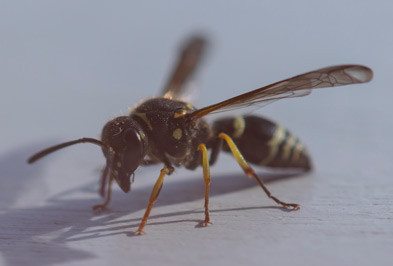Wasps & Hornets
What do common stinging insects look like?
There are many stinging insects that can affect property owners in Houston. Some of the common ones that Holder’s Pest Solutions controls are:
- Paper Wasps– They are ¾ of an inch to 1 inch in length. Paper wasps have a distinguishable narrow or “pinched” waist, their wings fold lengthwise at a 45 degree angle when at rest. They are brown in color with yellow markings on their head, thorax and abdomen.
- Yellow Jackets– There are many different species of this insect, but most range in length from 3/8 to 5/8 in length with the queens being slightly longer; they are black with yellow markings on their abdomens. Yellow jackets are a ground nesting species.
- Mud Daubers– They are a solitary wasp species that range in length from ¾ to 1 inch in length. Mud daubers have a long narrow waist and range in color from brown to black and have bright yellow to iridescent blue markings.
- European Hornets-They are a large, aggressive species; they range in length from 1 inch to 1 3/8 inch. European hornets are yellow and brown in color and the only “true” hornet living in North America. They nest in hollow spaces of trees or walls.
- Baldfaced Hornets– They have very distinct ivory-white markings on their heads, thorax, legs and abdomen and their wings are a smoky gray color. They can grow up to ¾ of an inch in length. Baldfaced hornets are a social wasp that make their nests in trees and shrubbery.
Why do I have this problem?
Stinging insects are most likely on your property looking for a food source or nesting area. The queen will emerge after the winter months and look for areas to nest in; depending on the species they will eat pollen, nectar and other insects. The queen will also look for an area with a water source such as a pond, bird bath or pools.
What kind of threat do stinging insects pose?
Many of the stinging insects species are known as nuisance insects because the normally do not do significant damage to your home or property; the exception to this is the damaging carpenter bee. However several of the species are aggressive and have powerful stings. These stings can cause strong allergic reactions that can lead to death in some. If you notice that you have a stinging insect colony around your home it is best to call in a professional exterminator to handle them.
How do I control stinging insects?
Eliminating stinging insects from your property can be a difficult task. There is the possibility of being stung and if you do not destroy the entire colony the remaining insects will most likely come back and rebuild their nest. Contacting the professionals at Holder’s Pest Solutions is the safest and quickest way to handle stinging insects. Contact us today to find out more about stinging insects and how we can help rid them from your home or business.
Related Post From Our Blog
The Life Cycle of Weather and Pests
As time passes following Hurricane Harvey, Holder’s phone continues to ring with new pest questions daily. Houston’s weather is still readjusting from the extreme moisture, which means pests are too. We are here to explain [...]
Enjoy National BBQ Month Bug-Free
As you may already know, May is national barbecue month. Although the month is coming to a close, barbecue season continues year-round in Houston – so there’s plenty of time to load up the grill [...]
Forecast Calls for Increased Flying Pest Population in Houston
With warmer, wetter spring weather on its way, we can expect to see a higher than normal flying pest population this year. Houston’s winter weather brought warmer than normal temperatures – who remembers the 80-degree [...]
Wasps & Hornets Serving
Houston




